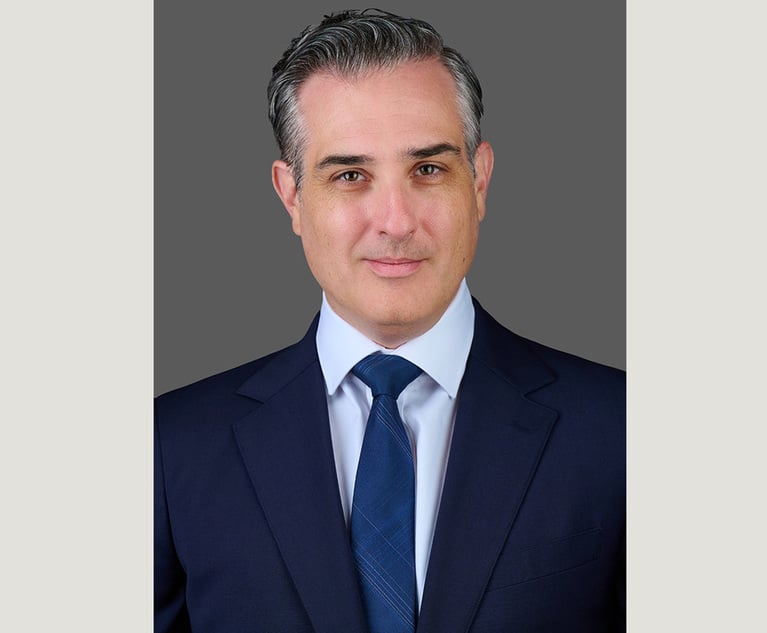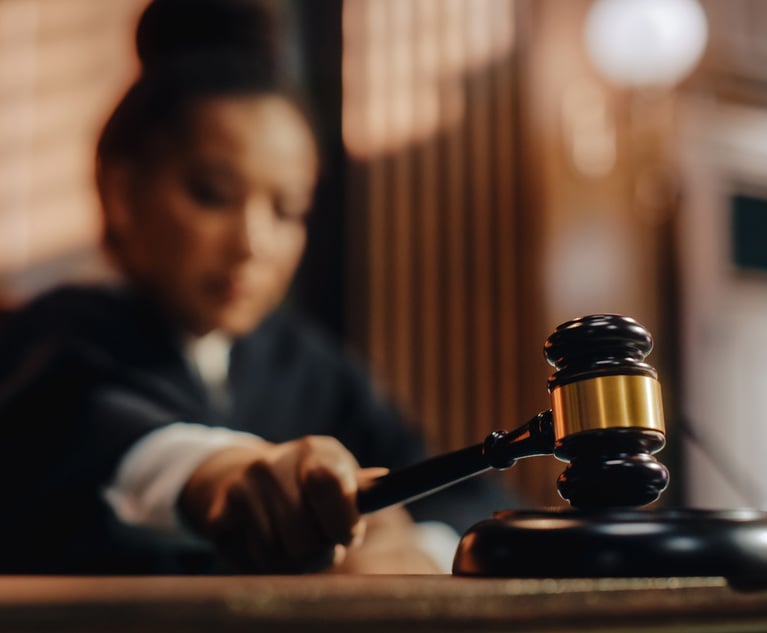3rd Circuit: Proof of 'but-for' Causation Required in FCA Retaliation Cases
The Third Circuit has ruled that plaintiffs must prove "but-for" causation in workplace retaliation lawsuits stemming from False Claims Act whistleblowing activity.
January 03, 2018 at 03:50 PM
5 minute read
 Getty Images/iStockphoto
Getty Images/iStockphoto
The U.S. Court of Appeals for the Third Circuit has ruled that plaintiffs must prove “but-for” causation in workplace retaliation lawsuits stemming from False Claims Act whistleblowing activity.
A three-judge Third Circuit panel consisting of Judges Thomas I. Vanaskie and Senior Judges D. Michael Fisher and Marjorie Rendell reached the decision in DiFiore v. CSL Behring, affirming a defense verdict.
The suit stems from plaintiff Marie DiFiore's claims that she was forced to resign for complaining about pharmaceutical company CSL Behring's off-label marketing of certain drugs. The defendant argued that DiFiore did not provide sufficient evidence to prove that the alleged retaliatory conduct met the definition of an “adverse action” under the FCA, and a jury ultimately found in favor of the company.
DiFiore argued that the district court applied the wrong causation standard for her FCA case by using the “but-for” standard instead of the “motivating factor” standard. She also argued that the court should not have dismissed her constructive discharge claim. Lastly, DiFiore claimed the court mischaracterized the adverse actions she experienced to the jury.
“The district court correctly applied Supreme Court case law when it instructed the jury using the 'but-for' causation standard for DiFiore's FCA relation claim,” Fisher wrote in the court's opinion, citing two U.S. Supreme Court cases: Gross v. FBL Financial Services, from 2009; and University of Texas Southwestern Medical Center v. Nassar, from 2013.
The Third Circuit also pointed to its own 2017 decision in Egan v. Delaware River Port Authority, which examined “but-for” causation in the context of Family and Medical Leave Act retaliation claims.
In Egan, according to Fisher, the plaintiff argued that the district court should have given a mixed motive instruction, requiring less than ”but-for” causation, because the FMLA regulation at issue barred employers from considering the use of FMLA leave as a ”negative factor” in employment decisions.
The Egan court agreed and lessened the causation standard in FMLA retaliation cases, distinguishing the FMLA's “negative factor” language from the language in the Age Discrimination in Employment Act that prohibits employers from firing or refusing to hire a person “because of” their age. That “because of” language is what led the Gross court to uphold the higher “but-for” causation standard in ADEA retaliation cases.
Fisher said the ruling in Egan was instructive in DiFiore's case.
“Unlike the language of the FMLA anti-retaliation regulation, the language of the FCA anti retaliation provision uses the same 'because of' language that compelled the Supreme Court to require 'but-for' causation in Nassar and Gross,” Fisher said. “For this reason, the district court correctly instructed the jury that to find retaliation, it had to find that DiFiore's protected conduct was the 'but-for' cause of the adverse employment action.”
The court rejected DiFiore's reliance on its 2001 decision in Hutchins v. Wilentz, Goldman & Spitzer.
“DiFiore argues that this court's decision in Hutchins controls and compels the application of the 'motivating factor' standard. This argument fails because the language DiFiore relies on in Hutchins was dictum,” Fisher said. “In Hutchins, we affirmed a grant of summary judgment in favor of an employer on an FCA retaliation claim because the employee failed to prove that he engaged in protected conduct and that he had put his employer on notice of possible FCA litigation. Because he failed to meet these elements, we never applied the causation standard, which we recited in dictum as the 'motivating factor' standard. That dicta does not compel us to apply the standard here.”
As for DiFiore's constructive discharge claim, Fisher said it failed under both state and federal law because she failed to demonstrate she suffered from oppressive conditions at work, which DiFiore claimed included warning letters, being placed on an improvement plan, and deteriorating relationships with her supervisors.
“She may have been subjected to difficult or unpleasant working conditions, but these conditions fall well short of unbearable,” Fisher said. “Importantly, DiFiore did not sufficiently explore alternative solutions or means of improving her situation.”
In response to DiFiore's claim on jury instruction—in which the district court told the jurors to focus on four specific incidents of alleged retaliation, while not mentioning others—could have confused the jury, Fisher said the court acted correctly.
“The district court correctly instructed the jury that its determination should take into account the totality of the circumstances,” Fisher said. “The court instructed that the four events occurred 'among other things,' and it described DiFiore's allegation that her supervisors began to treat her in a hostile manner after she raised her concerns. These instructions do not misstate the law and do not mislead, prejudice, or confuse the jury.”
James A. Bell IV of Bell & Bell in Philadelphia represents DiFiore and did not respond to a request for comment.
Counsel for CSL Behring, David S. Fryman of Ballard Spahr in Philadelphia, sent a statement from the company in an email, which read: “We are pleased the 3rd Circuit Court of Appeals has upheld the dismissal of DiFiore v. CSL Behring. CSL Behring has a demonstrated track record of operating its business with the highest ethical standards and remains committed to providing life-saving therapies to patients in need.”
This content has been archived. It is available through our partners, LexisNexis® and Bloomberg Law.
To view this content, please continue to their sites.
Not a Lexis Subscriber?
Subscribe Now
Not a Bloomberg Law Subscriber?
Subscribe Now
NOT FOR REPRINT
© 2025 ALM Global, LLC, All Rights Reserved. Request academic re-use from www.copyright.com. All other uses, submit a request to [email protected]. For more information visit Asset & Logo Licensing.
You Might Like
View All
People in the News—Jan. 9, 2025—Rawle & Henderson, Armstrong Teasdale
3 minute read


Phila. Court System Pushed to Adapt as Justices Greenlight Changes to Pa.'s Civil Jury Selection Rules
5 minute readTrending Stories
Who Got The Work
Michael G. Bongiorno, Andrew Scott Dulberg and Elizabeth E. Driscoll from Wilmer Cutler Pickering Hale and Dorr have stepped in to represent Symbotic Inc., an A.I.-enabled technology platform that focuses on increasing supply chain efficiency, and other defendants in a pending shareholder derivative lawsuit. The case, filed Oct. 2 in Massachusetts District Court by the Brown Law Firm on behalf of Stephen Austen, accuses certain officers and directors of misleading investors in regard to Symbotic's potential for margin growth by failing to disclose that the company was not equipped to timely deploy its systems or manage expenses through project delays. The case, assigned to U.S. District Judge Nathaniel M. Gorton, is 1:24-cv-12522, Austen v. Cohen et al.
Who Got The Work
Edmund Polubinski and Marie Killmond of Davis Polk & Wardwell have entered appearances for data platform software development company MongoDB and other defendants in a pending shareholder derivative lawsuit. The action, filed Oct. 7 in New York Southern District Court by the Brown Law Firm, accuses the company's directors and/or officers of falsely expressing confidence in the company’s restructuring of its sales incentive plan and downplaying the severity of decreases in its upfront commitments. The case is 1:24-cv-07594, Roy v. Ittycheria et al.
Who Got The Work
Amy O. Bruchs and Kurt F. Ellison of Michael Best & Friedrich have entered appearances for Epic Systems Corp. in a pending employment discrimination lawsuit. The suit was filed Sept. 7 in Wisconsin Western District Court by Levine Eisberner LLC and Siri & Glimstad on behalf of a project manager who claims that he was wrongfully terminated after applying for a religious exemption to the defendant's COVID-19 vaccine mandate. The case, assigned to U.S. Magistrate Judge Anita Marie Boor, is 3:24-cv-00630, Secker, Nathan v. Epic Systems Corporation.
Who Got The Work
David X. Sullivan, Thomas J. Finn and Gregory A. Hall from McCarter & English have entered appearances for Sunrun Installation Services in a pending civil rights lawsuit. The complaint was filed Sept. 4 in Connecticut District Court by attorney Robert M. Berke on behalf of former employee George Edward Steins, who was arrested and charged with employing an unregistered home improvement salesperson. The complaint alleges that had Sunrun informed the Connecticut Department of Consumer Protection that the plaintiff's employment had ended in 2017 and that he no longer held Sunrun's home improvement contractor license, he would not have been hit with charges, which were dismissed in May 2024. The case, assigned to U.S. District Judge Jeffrey A. Meyer, is 3:24-cv-01423, Steins v. Sunrun, Inc. et al.
Who Got The Work
Greenberg Traurig shareholder Joshua L. Raskin has entered an appearance for boohoo.com UK Ltd. in a pending patent infringement lawsuit. The suit, filed Sept. 3 in Texas Eastern District Court by Rozier Hardt McDonough on behalf of Alto Dynamics, asserts five patents related to an online shopping platform. The case, assigned to U.S. District Judge Rodney Gilstrap, is 2:24-cv-00719, Alto Dynamics, LLC v. boohoo.com UK Limited.
Featured Firms
Law Offices of Gary Martin Hays & Associates, P.C.
(470) 294-1674
Law Offices of Mark E. Salomone
(857) 444-6468
Smith & Hassler
(713) 739-1250





